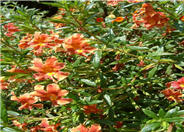
Common name:Dr. Hurd Tree Manzanita
Botanical name:Arctostaphylos manzanita 'Dr. Hurd'
This is a large shrub that has a tree-like shape,reaching 8-20' tall and wide. It has dark red bark with multi-branched form, large pale green leaves, and white to pink flower clusters that bloom in winter. This shrub can be grown near the ocean but also in warm inland valleys. It prefers full sun and is drought tolerant once it's established.

Common name:California or Golden Poppy
Botanical name:Eschscholzia californica
This small annual (sometimes acts as a perennial) plant will grow to less than 1' tall and has light, small blue-green leaves with gold and orange flowers that bloom in spring and summer.

Common name:White Sage, Sacred White Sage, Bee
Botanical name:Salvia apiana
This woody shrub has long stems with silvery white leaves and fragrant white flowers that bloom in the spring. It provides a strong sturctural form as a garden focal point. It can reach 3'-5' tall and 6' wide. White sage prefers full sun and moderate amount of watering.

Common name:Bush Anemone
Botanical name:Carpenteria californica
This California native is a dense, clean evergreen shrub that grows 6'-8' high and 5' wide. It is tolerant of sun or shade. It has white fragrant flowers with yellow stamens flowers that bloom in spring and summer. This shrub makes a great privacy hedge. It is drought tolerant once it's established but will appreciate extra watering during hot summer months.

Common name:Red Monkey Flower
Botanical name:Mimulus puniceus
Red Monkey Flower is an evergreen shrub that reaches 1.5'- 3' tall with numerous red orange tubular flowers in spring and summer. It is a California native that is drought tolerant. It attracts hummingbirds.

Common name:Blue Blossom Ceanothus
Botanical name:Ceanothus thyrsiflorus 'Skylark'
The Blue Blossom Ceanothus is a shrub that has dark blue flower clusters that bloom profusely in the spring . 'Skylark' grows to 5' tall and wide. This shrub attracts butterflies, hummingbirds and beneficial insects. Evergreen foliage is dark green and shiny, densely covering the plant. 'Skylark' tolerates heat better than other cultivars. It is drought tolerant once it's established. It prefers full sun to partial shade.

Common name:Coast Redwood, Redwood
Botanical name:Sequoia sempervirens
This fast-growing, aromatic tree has soft, dark green foliage with long needles appearing in flat sprays and brown, barrel-shaped cones that appear after 1 year. Its soft, red-brown bark is fiberous and furrowed. Particularly after mechanical damage, this tree will stump sprout to form new, young trees around the stump. Avoid planting in areas of high foot traffic. Inadequate moisture or a hot, dry site will inhibit its growth.

Common name:California Coffeeberry
Botanical name:Rhamnus californica
The California Coffeeberry is an evergreen shrub that reaches 3'-15' high. It has red berries that turn black in late summer, which attracts birds. This shrub tolerates sun or partial shade in all soil types. This CA native is drought tolerant once it's established. It is a beneficial insect plant and attracts butterflies. In ocean areas, this plant looks more like a ground cover. Small flowers appear in spring but are considered insignificant.

Common name:Incense Cedar
Botanical name:Calocedrus decurrens
The cedar is an attractive, stiff, narrow evergreen tree which has a columnar growing pattern and maintains a central leader. The foliage is comprised of scale needles, while the coarse bark has an attractive cinnamon red-brown coloring. The cedar typically retains its color in winter. It serves as an effective screening. It will slowly grow to 30' tall and 15' wide. Small brown cones appear in summer. Foliage is aromatic when brushed. It has low watering needs once it's established.
| Designer: | Side Bed |
Photographer: GardenSoft |
Soils and Compost:
Physical weed control, including mulching, or hand removal protects the watershed from harmful chemicals.
Water Saving Tip:
Change spray sprinklers to low-flow bubbler or drip systems. Shrubs and trees are ideal candidates for this type of irrigation because the water is applied directly to the root zones.
Integrated Pest Management:
Drip and other smart irrigation delivers water directly to roots, allowing no excess water for weeds.

